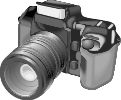These days, it seems, digital is the way to go. From cameras to cellphones, or stereo systems to television, businesses everywhere tout products that contain superior digital quality. Newer, digitally-oriented technology is quickly replacing all kinds of older technology. Cassettes, for example, are being replaced by CDs, television is being replaced by HDTV, and many cameras are being replaced by digital equivalents. So if something is digital, is it always better than its alternative?
Absolutely not. One prime example in the digital camera realm is the difference between digital and optical zooms.
A typical digital camera may indicate it contains a 3X optical zoom and an 8X digital zoom, claiming an effective 24X zoom. While the claim isn’t an outright lie, it is far from the truth and definitely misleading. Contrary to popular opinion, a digital zoom isn’t a true zoom, and actually decreases the quality of the image. Explaining how each works may illustrate why.
An optical zoom is a camera’s primary zoom, and operates almost exactly like the zoom of a film camera – like a pair of binoculars or a spotting scope, using properties of light and focus to bring the image closer to view. In other words, optical magnification is handled by the camera’s lens assembly.
In contrast, a digital zoom is the camera’s secondary zoom, which simply crops or trims the digital image captured by the camera’s CCD or CMOS sensor in an attempt to make the subject larger.
In reality, the subject is not increased in size. As the pixel dimensions of the image are decreased, the subject of interest becomes larger in proportion to the total size of the photo. Often, the image is then stretched and resized, so it appears that the subject is larger.
To clarify, a digital zoom can be compared to an image viewing program on a computer. As the person magnifies the image on the screen, the viewable portion of the image decreases (less of the image “fits” on the screen) while the amount of “pixelation” – that is, the appearance of individual pixels, increases. The end result makes the subject of interest in the image larger in proportion to the rest of the photograph, but the final dimensions of the photo decrease, effectively decreasing the photo’s megapixel rating.
Some cameras will then resize such an image to the size prior to the digital crop before it is written to the camera card. This process, called “interpolation,” attempts to intelligently fill in the “missing gaps” in the image caused by the crop, so that all image on the the camera card (regardless of the zoom used) have the same dimensions. Unfortunately, because the interpolation process is still guess work, the image won’t have the clarity or sharpness of a non-cropped, non-interpolated image (taken without a digital zoom).
It is extremely important that the buyer understand what the digital zoom does. Most people will likely find that the digital zoom does not do what what they expect it to do, and may be disappointed with their photos, especially when in printed form. A digital zoom, when included with an optical zoom, isn’t necessarily a bad thing. However, a camera with no optical zoom is a camera with NO zoom.
Have comments or suggestions for a weekly Tech Tips article? Send an email to webmaster@sunad.com.
Understanding Digital Cameras, Part V

